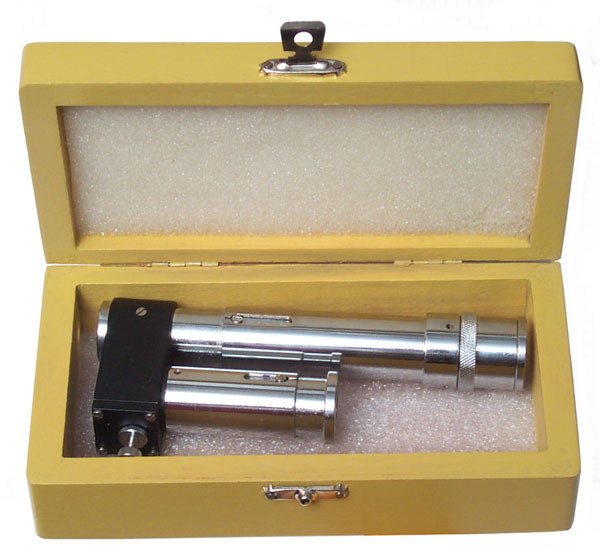Monolight Optical Spectrum Analyzer
&
Beseler PM1 Darkroom Color Analyzer
&
Wollensak L3524D Direct Vision Spectroscope
&
Ocean Optics HR2000 Spectrometer
Welch Teaching Spectroscope
© Brooke Clarke 2007 - 2010
I'd like to be able to measure the
spectrum from LED and found these Monolight Optical Spectrum
Analyzers on eBay. They use an optical grating that's
rotating to scan a spectrum. A scope, analyzer box or custom
PIC micro controller can read the brightenss on the diode as a
function of the time since the motor trigger (index) pulse.
For more on how they work see the
Wiki article
on the Monochromator. For a lot more technical deepth
see
The
Optics of Spectroscopy - A TUTORIAL on the
Horiba Jobin Yvon website
(they make gratings).
Historically spectral analysis is the basis of a great part of
modern physics. For more see the
References paragraph on my Fire web
page.
OSA
Mfg.
|
Monolight
Instruments Ltd.
|
Rofin
Sinar
Laser
|
| Model |
6101
|
6102
|
Mirror
|
N
|
O
|
Grating
|
1200/500
|
600/1000
|
s/n
|
053040
|
S2201
|
hand
label
|
350-1100
nm
|
700 to
2200 nm
guess
|
Rofin seems to be a high power laser maker and no longer offers
this product.
Macam Photometrics is still in business and offers a number of
optical products, although their
web page for the
Monolight is sparse. I hope they have manuals for
these.
Description
The optical assembly is wrapped in
black plastic to minimize stray light. There is some
relation between the grating lines/mm (1200 or 600) and the
spectrum that can be displayed at the first order. A low
or high pass filter may be needed at the input to limit the
wavelength entering the OSA so that the harmonics do not show
up.
The second grating number may be the "blasť" (500 or 1000) and
is the wavelength where the performance is best, so for the 6101
it would be optimized for visible light and the 6102 for near IR
light.
Considering the short length of the cables on the photo diodes
and the labels AMP In and Out, it's likely that photo diode gets
connected to the Amp In BNC jack. The holes in the optical
assembly are different diameters for the 6101 and 6102 with the
6102 having the larger hole. The photo diodes are also
different diameters so they are shown above in the correct
column.
The input block and seperate output block of the optical
assembly can be moved about 1/4 inch which may be for
calibration or peaking of the response.
There is a metal template on the optical assembly with different
slit sizes.
The function of the 7 socket DIN connector is a mystery.
Sensors
Round
|
Rectangular
|
RS06112
|
6111
|
Power
Both OSAs are marked as using 18 VAC @ 200 ma and that's what the
label on the wall wart Power Cube says.
Operation
When the power connector is connected with you ear on the box you
can just hear the motor running.
The Trig Out has a pulse about 3 ms wide with a period very close
to 100 ms.
Triggering a scope from that pulse and then looking at the Amp Out
sometimes shows a repeated pattern when a bright LED flashlight is
shined into the input slit.
Maybe an optic is needed to focus the input light on the slit?
Related
W's
Laser-Projects
page ! -
Rofin-Sinar
RSO 6000 Scanning Monochromator/Optical Spectrum Analyzer -
a web page by someone interested in lasers. Has photos of
inside of the optical assembly with green laser light beam.
There's a notch in the metal side wall that appears to be there to
allow light to escape from the OSA and maybe go somewhere else?
Also shown is an EG&G
Gamma Scientific 6200
Control box connected to the 6000 series OSA.
Front Panel
Speed pot & switch for Internal, AC or External
4 digit thumbwheel switch for wavelength (1100 near IR shown)
analog meter reading 0 to 100 (%?)
Two knobs under the wavelength thumbwheels with unknown function
a GAIN adjustment knob
A LED for Auto Scan On
Another LED for unknown function
what may be a MODE switch with mention of a Scope
Rear Panel
Switch Autoscan On/Off
Scan Speed switch nm/sec 1(?) or 10(?)
3 more switches unknown label
4 BNC jacks the left 3 associated with a chart plotter and the
right 3 with a computer
? Ext Trigger Input BNC
??G In (SIG or TRIG?)
3 BNC jacks to drive a Scope
another BNC jack?
The 6200 may generate small markers each 1 nm and higher ones
every 10 nm. (scope in X-Y mode)
Patents
2516672 Apparatus for Measuring
Radiant Energy, F. G. Brockman (Socony-Vacuum Oil Co), Jul 1950,
338/18 ; 246/DIG.1;
250/339.04; 250/339.06; 330/109; 330/117; 330/119; 330/146;
330/81; 330/92; 338/19; 338/199; 338/237; 338/25; 346/33A;
346/33B; 346/33R; 374/121; 374/163
Vacuum tube OSA
Beseler PM1 Darkroom Color Analyzer
Front panel says pm1 color analyzer
by beseler
Solid State Photo Multiplier Internally Stabilized
It seems to work. For each filter position you can adjust
the pot to get a zero center reading on the meter.
Using a different light source, like different LEDs gives very
different pot readings. Although the pots are dirty and need
a squirt of cleaner.
Got this for almost nothing on eBay, maybe because of the missing
color dots on the pots or maybe because film is becoming obsolete
for many applications.
If you know of a free manual
tell me
where to get it. The manuals I've seen for sale cost many
times what I paid for the analyzer.

|
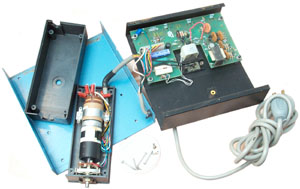
|
Hole in
white field is input to PMT.
On-Off Switch
Zero center meter
Adjustment post for Cyan, Yellow, Magenta and White Filter
switch on side for same colors
|
Black
box made in England has PMT and switch that selects
color filter and which channel meter reads.
|
Wollensak L3524D Direct Vision Spectroscope
Background
The eyepiece is shown at the
left. The short tube on the right contains the wavelength
scale which is focused by sliding the tube in and out. The
longer tube contains the grating which is focused by sliding it in
and out. The knurled ring on the long tube can be turned
over a small range to control the brightenss of the incoming
light. The knurled screw and lock nut adjust the scale
display relative to the spectrum display. Note the spectrum
scale shows 750 (nm) on the left and 400 (nm) on the right.
Between the lines for 575 and 600 is a longer line marked "D" for
the Sodium "D" line (Wiki:
Na)
used to adjust the scale position.
Calibration
First focus the scale and
spectroscope tubes by looking at something that has a line
spectrum like a computer monitor (not a hot body that has a broad
spectrum where there are no lines to focus on). The focus
needs to be done first since changing the spectroscope focus moves
the spectrum it generates.
Some table salt (NaCl) on aluminum foil produces a line at 589
nm. Note the Al foil will melt in the stove's gas flame
bringing salt into the flame. and turning the knurled ring
to dim the line allows the cal screw to be set and the nut
tightened bringing the yellow line onto the "D" reference line.
Using
The spectroscope is held with the
long tube to the right (causes the wavelength scale numbers to be
right side up). For me taking off my reading glasses allows
better focus of both the scale and spectrum by extending or
retracting the two front tubes.
Ocean Optics HR2000 Spectrometer

This is a computer display from a
USB interfaced hand sized device. The software is about 50 M
Bytes. When run on a laptop the system becomes a portable
Optical Spectrum Analyzer. It coverts 467 nm to 670 nm i.e.
uses the H9 grating.
The plot below was taken on the CF-28 Toughbook in the TV room,
and printed as a pdf file to the local folder on my desktop
computer.
Acrobat Pro 9 exported a .tiff version of the .pdf which Photoshop
7 made into a web .jpg and here is is at about 1/5 actual size.
I think the sharp drop at the right is the glass cutting off the
UV lamp output.
Do you know what's making the spike at 434 nm?
Answer: A fluorescent light may be the cause of the spike at the
low end of the scale.
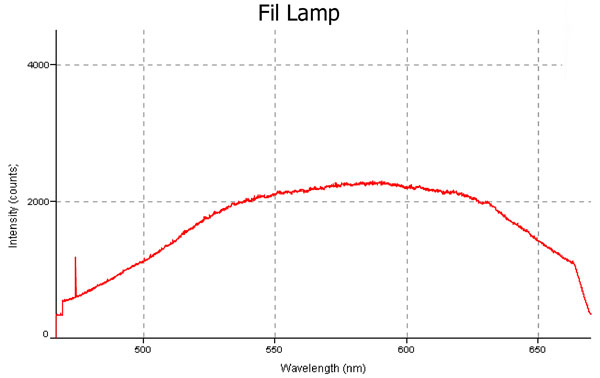
Since this is the first version (no letter suffix) the max count
is a little over 4000. If the integration time is too short
then the plot is a flat line at the dark current. If the
integration time is too long the plot flat tops at the top of the
plot. Uning the averaging function has the potential to
reduce the noise, but not to give you more counts.
Software
Ocean Optics has both complete PC
application software as well as drivers for various flavors of "C"
as well as a
LabVIEW driver (OmniDriver).
Hardware Interfaces
There are interfaces for SMA 901
Fiber Optic input; USB 1.1; 2x10 header with: RS-232, Serial
Clock and Data (micro Controller) as well as trigger inputs and
outputs.
Common Measurements
Absorbance
Transmission
Reflection
Relative Irradiance
HP 70950 Series OSA
Seem to be near IR OSAs.
70951A: 600 - 1700 nm
70952A (70952B): 600 - 1750 nm
The Model 20 uses an analog meter and the 20D uses LED digital
displays for both wavelength and transmission or absorbance.
Welch Teaching
Spectroscope
Fig 1

|
Fig 2
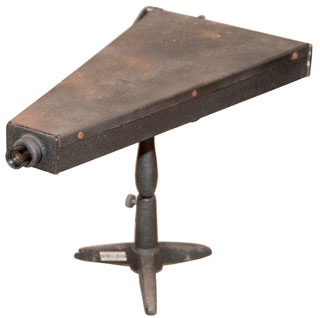 |
Fig 3
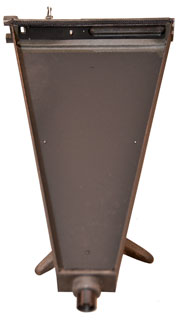 |
Fig 4
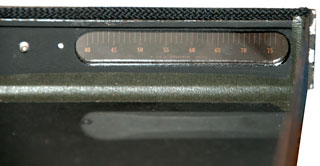 |
Yellow board/plastic? - film scale, glass
plate.
|
|
Looks empty, but . . .
Diffraction grating is in eyepiece
left half of slit mechanism removed to get cover off.
|
Scale from 40 to 75 x100 Angstrom Units(
4,000 to 7,000 angstroms).
400 to 700 nm
Front to back: glass, film scale, yellow board
|
2279646 Device for making spectral analyses, Smith
Frank P, Filed: Jan 31, 1939, Pub: Apr
14, 1942, 356/303, 356/315, 396/429,
356/328, 356/313, 250/226,
250/554, 356/305 -
EFI Spectrophotometer patents "X-Rite" "i1"
Mainly used for calibrating printers and monitors (YouTube).
Can also be used to measure ambient (or flashlight) light color:
Measuring Ambient Light
with X-Rite i1PRO.wmv - done using "advanced" Monitor
profiling mode , the LCD, CRT or Laptop choice does not matter
neither does the ambient room lighting choice matter but do
select ambient light check, attach ambient light head, calibrate
with the dark cover in place the remove to expose the diffuser,
It may be possible to use the Datacolor Spyder4
to measure flashlights.
This showed up in Candle Power Forums as a way to
measure the CRI (Wiki) of flashlights.
An eBay photo shows the label and patent numbers:
5483339
Spectrophotometer and radiometric measurement apparatus, Harold
Van Aken, Alan Kravetz, Kenneth Garde, William Weber, Joseph
Corrado, GretagMacbeth LLC, 1996-01-09 - for reflected light
6590648
Apparatus for measuring light, Adrian von Orelli, Peter Ehbets,
2003-07-08 - "for measuring light that is emitted, remitted, or
transmitted from a measuring object."
6606156
Spectrometer, Peter Ehbets, Adrian von Orelli, Eckard Vasold,
Wilhelm Schebesta, Carl Zeiss Microscopy GmbH, 2003-08-12 (X-Rite Switzerland GmbH)
- Fiber Optic input
7345763
Method for operating a color measurement system, Douglas V. Baker,
Mark A. Cargill, Bernard J. Berg, Stephen B. Rankin, James L.
Mourey, Robert L. Winchester, OTP Inc, X-Rite Inc, Pantone Inc,
Gretag Macbeth LLC, X-Rite Holdings Inc, X-Rite Global Inc, Monaco
Acquisition Corp, 2008-03-18 -
7492456
Method for operating a color measurement system
Building a simple
spectroscope
There are a number of how to articles and simple kits for doing
this. Here's how to make one using (1) a CD-ROM, (2)
Rainbow glasses, (3) diffraction gratings.
Sci-Toys: Building
a simple spectroscope -
The Remino: Theremino
Spectrometer - Technology.pdf
- Construction.pdf
(includes test light sources) -
Also see Radiation
Detectors Ref 2 - Ref 5.
Related
Links
ASEQ Instruments -
sells a couple of OSAs for reasonable prices as well as accessories.
Surplus Shed - Wollensak
spectrometers, both with and without the wavelength scale.
Roland
Guilmet - Ocean Optics HR2000 Spectrometer
Back to Brooke's Products
for Sale, Astronomy,
CCD Astronomy, Binoculars,
Optics, Electro
Optic Gadgets, LED, LCD, Military
Information, Home page
[an error occurred while processing this directive] page created 22 Dec
2007.
